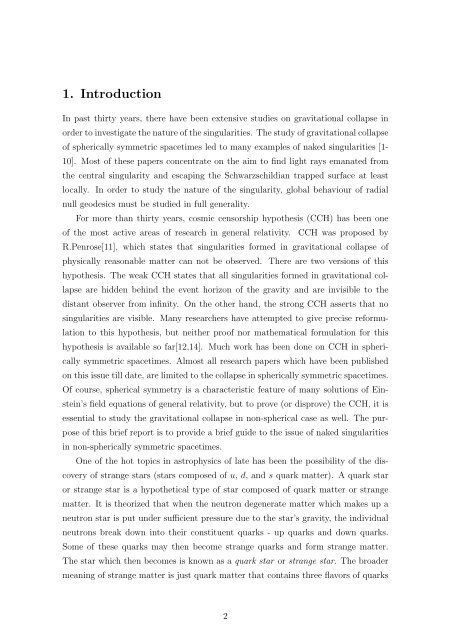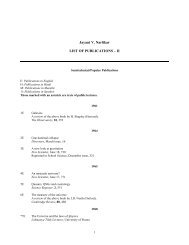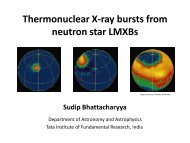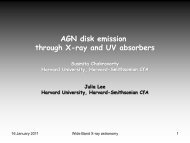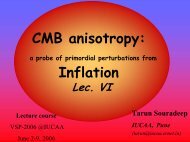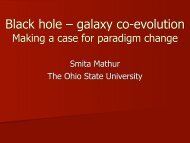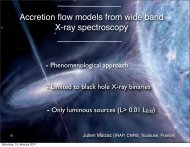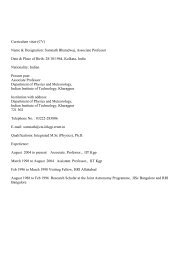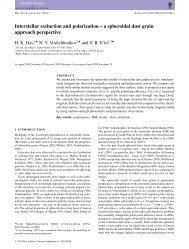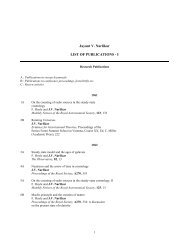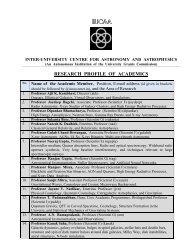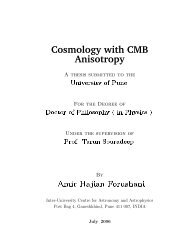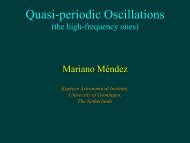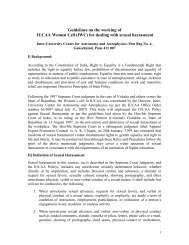Non-spherical gravitational collapse of strange quark matter - iucaa
Non-spherical gravitational collapse of strange quark matter - iucaa
Non-spherical gravitational collapse of strange quark matter - iucaa
You also want an ePaper? Increase the reach of your titles
YUMPU automatically turns print PDFs into web optimized ePapers that Google loves.
1. IntroductionIn past thirty years, there have been extensive studies on <strong>gravitational</strong> <strong>collapse</strong> inorder to investigate the nature <strong>of</strong> the singularities. The study <strong>of</strong> <strong>gravitational</strong> <strong>collapse</strong><strong>of</strong> <strong>spherical</strong>ly symmetric spacetimes led to many examples <strong>of</strong> naked singularities [1-10]. Most <strong>of</strong> these papers concentrate on the aim to find light rays emanated fromthe central singularity and escaping the Schwarzschildian trapped surface at leastlocally. In order to study the nature <strong>of</strong> the singularity, global behaviour <strong>of</strong> radialnull geodesics must be studied in full generality.For more than thirty years, cosmic censorship hypothesis (CCH) has been one<strong>of</strong> the most active areas <strong>of</strong> research in general relativity. CCH was proposed byR.Penrose[11], which states that singularities formed in <strong>gravitational</strong> <strong>collapse</strong> <strong>of</strong>physically reasonable <strong>matter</strong> can not be observed. There are two versions <strong>of</strong> thishypothesis. The weak CCH states that all singularities formed in <strong>gravitational</strong> <strong>collapse</strong>are hidden behind the event horizon <strong>of</strong> the gravity and are invisible to thedistant observer from infinity. On the other hand, the strong CCH asserts that nosingularities are visible. Many researchers have attempted to give precise reformulationto this hypothesis, but neither pro<strong>of</strong> nor mathematical formulation for thishypothesis is available so far[12,14]. Much work has been done on CCH in <strong>spherical</strong>lysymmetric spacetimes. Almost all research papers which have been publishedon this issue till date, are limited to the <strong>collapse</strong> in <strong>spherical</strong>ly symmetric spacetimes.Of course, <strong>spherical</strong> symmetry is a characteristic feature <strong>of</strong> many solutions <strong>of</strong> Einstein’sfield equations <strong>of</strong> general relativity, but to prove (or disprove) the CCH, it isessential to study the <strong>gravitational</strong> <strong>collapse</strong> in non-<strong>spherical</strong> case as well. The purpose<strong>of</strong> this brief report is to provide a brief guide to the issue <strong>of</strong> naked singularitiesin non-<strong>spherical</strong>ly symmetric spacetimes.One <strong>of</strong> the hot topics in astrophysics <strong>of</strong> late has been the possibility <strong>of</strong> the discovery<strong>of</strong> <strong>strange</strong> stars (stars composed <strong>of</strong> u, d, and s <strong>quark</strong> <strong>matter</strong>). A <strong>quark</strong> staror <strong>strange</strong> star is a hypothetical type <strong>of</strong> star composed <strong>of</strong> <strong>quark</strong> <strong>matter</strong> or <strong>strange</strong><strong>matter</strong>. It is theorized that when the neutron degenerate <strong>matter</strong> which makes up aneutron star is put under sufficient pressure due to the star’s gravity, the individualneutrons break down into their constituent <strong>quark</strong>s - up <strong>quark</strong>s and down <strong>quark</strong>s.Some <strong>of</strong> these <strong>quark</strong>s may then become <strong>strange</strong> <strong>quark</strong>s and form <strong>strange</strong> <strong>matter</strong>.The star which then becomes is known as a <strong>quark</strong> star or <strong>strange</strong> star. The broadermeaning <strong>of</strong> <strong>strange</strong> <strong>matter</strong> is just <strong>quark</strong> <strong>matter</strong> that contains three flavors <strong>of</strong> <strong>quark</strong>s2


